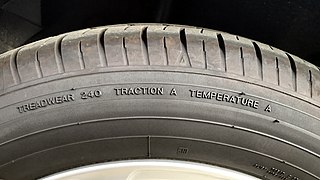Related Research Articles

A speedometer or speed meter is a gauge that measures and displays the instantaneous speed of a vehicle. Now universally fitted to motor vehicles, they started to be available as options in the early 20th century, and as standard equipment from about 1910 onwards. Other vehicles may use devices analogous to the speedometer with different means of sensing speed, eg. boats use a pit log, while aircraft use an airspeed indicator.

A dynamometer or "dyno" is a device for simultaneously measuring the torque and rotational speed (RPM) of an engine, motor or other rotating prime mover so that its instantaneous power may be calculated, and usually displayed by the dynamometer itself as kW or bhp.

Aquaplaning or hydroplaning by the tires of a road vehicle, aircraft or other wheeled vehicle occurs when a layer of water builds between the wheels of the vehicle and the road surface, leading to a loss of traction that prevents the vehicle from responding to control inputs. If it occurs to all wheels simultaneously, the vehicle becomes, in effect, an uncontrolled sled. Aquaplaning is a different phenomenon from when water on the surface of the roadway merely acts as a lubricant. Traction is diminished on wet pavement even when aquaplaning is not occurring.
Scrim can refer to:

Rolling resistance, sometimes called rolling friction or rolling drag, is the force resisting the motion when a body rolls on a surface. It is mainly caused by non-elastic effects; that is, not all the energy needed for deformation of the wheel, roadbed, etc., is recovered when the pressure is removed. Two forms of this are hysteresis losses, and permanent (plastic) deformation of the object or the surface. Note that the slippage between the wheel and the surface also results in energy dissipation. Although some researchers have included this term in rolling resistance, some suggest that this dissipation term should be treated separately from rolling resistance because it is due to the applied torque to the wheel and the resultant slip between the wheel and ground, which is called slip loss or slip resistance. In addition, only the so-called slip resistance involves friction, therefore the name "rolling friction" is to an extent a misnomer.

A tribometer is an instrument that measures tribological quantities, such as coefficient of friction, friction force, and wear volume, between two surfaces in contact. It was invented by the 18th century Dutch scientist Musschenbroek
Traction, traction force or tractive force is a force used to generate motion between a body and a tangential surface, through the use of either dry friction or shear force. It has important applications in vehicles, as in tractive effort.

Uniform Tire Quality Grading, commonly abbreviated as UTQG, is a set of standards for passenger car tires that measures a tire's treadwear, temperature resistance and traction. The UTQG was created by the National Highway Traffic Safety Administration in 1978, a branch of the United States Department of Transportation (DOT). All passenger car tires manufactured for sale in the United States since March 31, 1979 are federally mandated to have the UTQG ratings on their sidewall as part of the DOT approval process, in which non-DOT approved tires are not legal for street use in the United States. Light truck tires are not required to have a UTQG. It is not to be confused with the tire code, a supplemental and global standard measuring tire dimensions, load-bearing ability and maximum speed, maintained by tire industry trade organizations and the International Organization for Standardization.
Low rolling resistance tires are designed to reduce the energy loss as a tire rolls, decreasing the required rolling effort — and in the case of automotive applications, improving vehicle fuel efficiency as approximately 5–15% of the fuel consumed by a typical gas car may be used to overcome rolling resistance.

Braking distance refers to the distance a vehicle will travel from the point when its brakes are fully applied to when it comes to a complete stop. It is primarily affected by the original speed of the vehicle and the coefficient of friction between the tires and the road surface, and negligibly by the tires' rolling resistance and vehicle's air drag. The type of brake system in use only affects trucks and large mass vehicles, which cannot supply enough force to match the static frictional force.

Road slipperiness is a condition of low skid resistance due to insufficient road friction. It is a result of snow, ice, water, loose material and the texture of the road surface on the traction produced by the wheels of a vehicle.
Road surface textures are deviations from a planar and smooth surface, affecting the vehicle/tyre interaction. Pavement texture is divided into: microtexture with wavelengths from 0 mm to 0.5 millimetres (0.020 in), macrotexture with wavelengths from 0.5 millimetres (0.020 in) to 50 millimetres (2.0 in) and megatexture with wavelengths from 50 millimetres (2.0 in) to 500 millimetres (20 in).

Motorcycle testing and measurement includes a range of more than two dozen statistics giving the specifications of the motorcycle, and the actual performance, expressed by such things as the output of the engine, and the top speed or acceleration of the motorcycle. Most parameters are uncontroversial and claims made by manufacturers are generally accepted without verification. These might include simple measurements like rake, trail, or wheelbase, or basic features, such as the type of brakes or ignition system.

The international roughness index (IRI) is the roughness index most commonly obtained from measured longitudinal road profiles. It is calculated using a quarter-car vehicle math model, whose response is accumulated to yield a roughness index with units of slope. Although a universal term, IRI is calculated per wheelpath, but can be expanded to a Mean Roughness Index (MRI) when both wheelpath profiles are collected. This performance measure has less stochasticity and subjectivity in comparison to other pavement performance indicators, such as PCI, but it is not completely devoid of randomness. The sources of variability in IRI data include the difference among the readings of different runs of the test vehicle and the difference between the readings of the right and left wheel paths. Despite these facts, since its introduction in 1986, the IRI has become the road roughness index most commonly used worldwide for evaluating and managing road systems.
Speed skydiving is a skydiving competition in which the goal is to achieve and maintain the highest possible terminal velocity. It was developed in the late 1990s and is the fastest non-motorized sport on Earth. The speed, achieved by the human body in free fall, is a function of several factors; including the body's mass, orientation, and skin area and texture. In stable, belly-to-earth position, terminal velocity is about 200 km/h (120 mph). Stable freefall head down position has a terminal speed of 240–290 km/h. Further minimization of drag by streamlining the body allows for speeds over 500 km/h (310 mph).
Floor slip resistance testing is the science of measuring the coefficient of friction of flooring surfaces, either in a laboratory or on floors in situ. Slip resistance testing is usually desired by the building's owner or manager when there has been a report of a slip and fall accident, when there has been a report of a near accident, or (preferably) before the flooring is installed on the property. Flooring is tested using a tribometer to discover if there is a high propensity for slip and fall accidents on it, either dry and/or when wet with water or lubricated with other contaminants such as kitchen grease, hydraulic oil, etc. There have been numerous floor slip resistance testing tribometers and lab devices produced around the world to measure both the static (stationary) and dynamic coefficient of friction, but presently there are only a few that have been proven to be reliable for obtaining useful safety results and that have current official test methods. Static coefficient of friction (SCOF) testing has always been unreliable for assessing safety in the wet condition, so any reliable slip resistance test will be measuring the available slip resistance to someone who is moving (dynamic) across the floor, and therefore will be assessing dynamic coefficient of friction (DCOF). If an instrument has no official published test method, or has a withdrawn test method, then there is a problem with the instrument, often being poor precision.
There are at least three different types of brake tester used to calculate the braking efforts and efficiencies of a motor vehicle:

A chassis dynamometer, informally referred to as a rolling road or a dyno, is a mechanical device that uses one or more fixed roller assemblies to simulate different road conditions within a controlled environment, and is used for a wide variety of vehicle testing and development purposes.
References
- ↑ Hosking, JR, Woodford, GC (1 January 1976). measurement of skidding resistance part i. guide to the use of scrim. TRL (Report). Retrieved 14 May 2018.
{{cite report}}: CS1 maint: multiple names: authors list (link) - ↑ "SCRIM® / SCRIMTEX | W.D.M Limited".